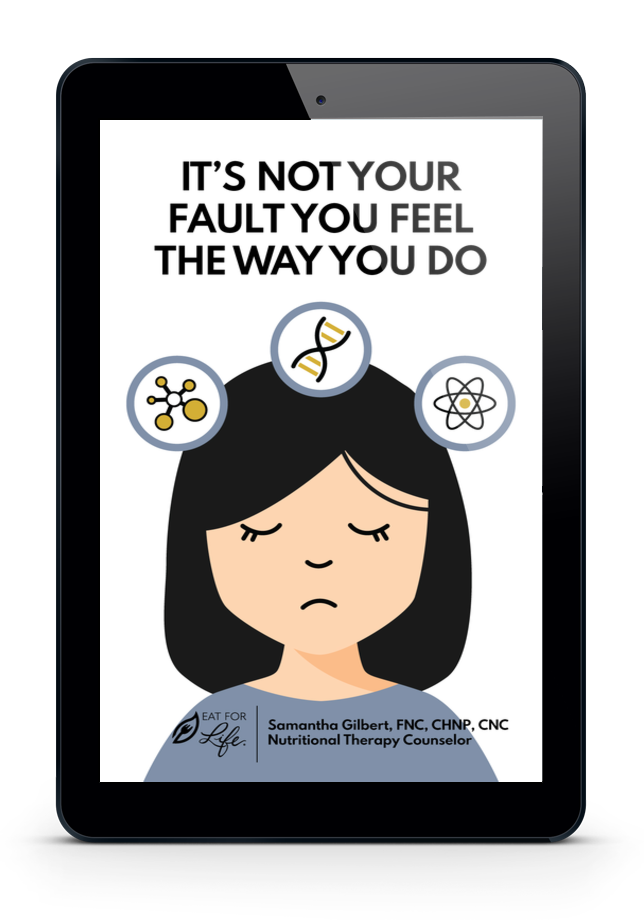Anxiety, anger, and stress are a normal part of the human experience. But if you find yourself unable to tolerate even the smallest amount of stress without feeling lots of anxiety and anger, you may have a little-known stress disorder known as Pyrrole disorder.
I talk about this disorder on my podcast with Dr. Judith Bowman, co-founder of Mensah Medical (click below to listen).
What is Pyrrole Disorder?
Pyrrole disorder (also called Pyroluria) occurs when a biochemical abnormality results in the overproduction of pyrrole molecules. Pyrrole molecules are excreted continuously in the urine and are normal by-products of hemoglobin synthesis and other bodily processes. For the average healthy person, this is not a problem. However, for someone with Pyrrole disorder, nutrient deficiencies occur because these molecules have an affinity for zinc and vitamin B6, causing them to latch onto and excrete them in the urine before the body can adequately absorb them, leading to severe oxidative stress.
Zinc and vitamin B6 are critical for neurotransmitter balance (serotonin, dopamine, norepinephrine), regulating hormones, a healthy immune system, and maintaining intellectual function, mood, and memory to name a few. Oxidative stress occurs when there’s an imbalance between free radical activity and antioxidant activity in your body. When functioning properly, free radicals can help fight off pathogens.
A mood and stress disorder, Pyroluria can be acquired but is often genetically inherited. I almost always see it when there is a long line of family alcoholism, depression, and anxiety, coupled with anger and rage. Northern European people groups most affected by Pyrrole disorder are the Irish, Welsh, English, and Scandinavian/Nordic peoples with light features, such as blonde or red hair and blue or green eyes.
Irish drinking and fiery redhead jokes all have their roots in pyroluria. However, contrary to popular belief, it can be seen in anyone of any age. Symptoms are typically most evident in toddlers (who present with the “terrible twos”) and teenagers with anger, rage and temper control problems who have not yet learned how to cope with the resulting behaviors this disorder creates.
The acquired form of Pyrrole disorder occurs during times of acute stress, illness, injury, and trauma because the body rapidly depletes zinc, vitamin B6, and other vital nutrients during these periods.
11 Signs You Have Pyrrole Disorder
In addition to the aforementioned anxiety, anger and inability to tolerate even mild forms of stress, pyroluric individuals also exhibit many of these symptoms (please note you don’t need all of them to have Pyrrole disorder):
- You’re a night owl with little or no dream recall and abnormal sleep cycles.
- You have a tendency to skip breakfast, usually due to morning nausea, or experience it at other times of the day or night.
- You’re sensitive to lights, odors, sounds, or textures (LOST).
- You struggle with depression, mood swings, poor short-term memory, and may have been diagnosed with ADHD.
- If you’re a woman, you may experience abnormal or absent menstrual periods or had delayed puberty.
- You have white spots on your nails, stretch marks on your body, pale skin and an inability to tan.
- You have an affinity for spicy and salty foods.
- You have joint pain, skin problems (psoriasis, acne, eczema), and poor wound healing.
- You have dark or mauve colored urine.
- You may have a history of underachievement or a reading disorder.
- You struggle with addiction and substance abuse issues (often alcohol or food).
Diet and nutrients are key for the pyroluric individual and must contain ample zinc and B6-rich proteins for calming anxiety and to balance blood sugar, as well as high-quality omega 6 fatty acids. It’s important to note that individuals with Pyrrole disorder should stay away from fish oils.
Healing leaky gut and malabsorption is also a factor in Pyrrole disorder and is an important part of the healing process.
Conditions and disorders associated with Pyrrole disorder include Bipolar disorder (especially rapid cycling), Autism, Schizophrenia, OCD, ADD/ADHD, Disruptive Mood Dysregulation Disorder (DMDD), Tourette syndrome, Multiple Sclerosis, Parkinson’s disease, Asperger syndrome, alcoholism, epilepsy, Down syndrome, and Porphyria.
Testing for Pyrrole Disorder
Pyrrole disorder is diagnosed by finding elevated kryptopyrroles (Kp) in urine. Keep in mind most doctors have never heard of this disorder and won’t test for it.
Chemical analysis for Kp is difficult due to the tendency for Kp to decompose if the sample is not kept frozen and away from light. Correctly interpreting Kp results is dependent not only on proper collection technique but also on individual and familial history, as well as current symptoms.
I break down the science of Pyrrole disorder, along with delicious recipes, food lists, and meal plans in my Healing Guide for Pyrrole Disorder.
If you have a loved one who is struggling with anxiety or any of the above symptoms and disorders then be hope for them by sharing this post! Pyrrole disorder can be safely corrected with dietary and nutrient therapy.







9 Responses
I love ❤️ it . Thank you ????
????
Hi Sami, my 9 year old son was diagnosed with this about 2 years ago. Per the ND, I started him on zinc and b6 (25mg each). I gave them separately (started with zinc first). He had quite an emotional, depressive meltdown. Two weeks later, I gave the b6. He became enraged. It took two weeks for these effects to diminish – all of this after one single dose of each. I still haven’t figured out why. Do you have any insight? Is this possibly from low magnesium?
Hi Mary – your son probably has a leaky gut/dysbiosis, candida/bacterial overgrowth. B6 can trigger yeast terribly in a child and is something I always look at when working with children, especially children with Pyrrole disorder.
Hello Mary, I sympathize with your ordeal with your son. That had to be very difficult. May I ask if you also gave him a binder with the zinc? When the body can’t hang onto zinc, it will subtitute a heavy metal like mercury, lead, or cadmium–whatever is available, in an attempt to subsitute for the zinc that it needs. When it finally gets some zinc, it starts unloading heavy metals which would account for his meltdown and rage. These metals need something like chlorella or a safe zeolite ( I have heard that some liquids are dangerous but I can’t remember why–I’m sorry. I know that Zeobind from Biopure is considered safe and good.) to bind to the heavy metals and then pass them from the body via the stool. I am not sure why the B6 induced rage, but I suspect it’s a similar reaction. Probably his body was detoxifying and causing all this. I hope he’s better now.
My son has been on the protocol for over 6 months now with no improvement. His gut is terribly unhealthy. Do we need to stop the protocol to heal the gut first? The supplements make him feel sick and he’s about ready to refuse taking them anymore.
Hi Sarah – I’m not sure what protocol he is on, but if he has gut dysbiosis, that also needs to be taken into consideration as some nutrients can exacerbate yeast/bacteria. Click here for more information about working with me.
I feel like that there has been no end in sight to what I have going through every single day. It has also gotten worse every single year without any signs of it getting better. ????
I am so sorry you are struggling, David. I know firsthand how you are feeling.